« July 2012 | Main | September 2012 »
August 30, 2012
White Vengeance

Hong men yan
Daniel Lee - 2011
Well Go USA Entertainment Region 1 DVD
The Chinese title refers to the meeting place between two former allies, turned rivals, fighting for political and military power, approximately two hundred years B.C. The English title would be a symbolic reference to the colored pieces of the game Weiqi, also known as Go, the Chinese game of strategy using identical black and white "stones". This is a historical drama with several big battle scenes, but the heart of the film is about the strategy used by the principal characters.
The basic story is not well known, even for Chinese audiences. Essentially Liu Bang and Xiang Yu are leaders of their respective armies. When they realize they have a common enemy in the Qin feudal lord, they join forces. It is also understood that whomever conquers the city of Guanzhong first is entitled to claim a royal title. Both men have their reasons for wanting to claim the throne. What follows is gamesmanship with exchanges of power, and a variety of shifting alliances.

This film might be considered something of a companion piece to Daniel Lee's Three Kingdoms: Resurrection of the Dragon from 2008. The main difference is that some of the battles are off the field with the games of weiqi, and discussions of loyalties and protocol. More so than some of the other Chinese films I've seen, White Vengeance might require a bit more attention from western viewers as the historical details and cultural aspects might strike some as arcane.
More easily understood is the relationship between Xiang Yu and his wife, Yu Ji. No matter that Xiang Yu and Liu Bang have sworn to kill each other, they are both protective of Yu Ji. And don't be surprised if the actress who plays Yu Ji, Liu Yi Fei, becomes the next Chinese actress to become an international star. Miss Liu is so cute that it just seems right that CGI cherry blossoms swirl around her.
The supplemental interview with Daniel Lee is helpful in gaining a bit more historical context to the film. One of the stars, Anthony Wong, also adds some interesting insight regarding cultural differences between Chinese and westerners. As befitting a historical epic, White Vengeance was nominated for the costume design for the Asian Film Awards and the Hong Kong Film Awards. Daniel Lee was also nominated for his production design. Lee certainly takes advantage of the mountain and desert settings, as well as the several very large armies that fight each other on the otherwise desolate landscape. Very fitting is when Xiang Yu and Yu Ji realize that they may not have much of a future to look forward to, and the space in front of them is wide open and empty.

Posted by Peter Nellhaus at 07:29 AM | Comments (1)
August 28, 2012
Quick
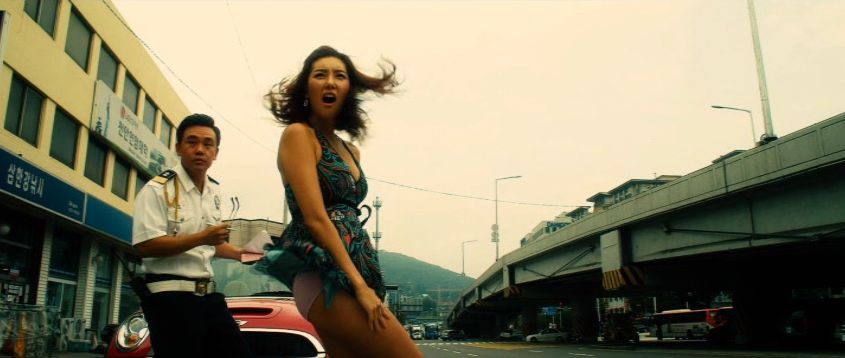
Jo Bum-Gu - 2011
Shout! Factory Region 1 DVD
The more serious minded, with longish memories, are apt to dismiss Quick as not much more than a loose remake of Speed. Keep in mind that the older film came out in 1994, and this new film is aimed squarely at the Korean teenagers, whose parents were the ones to watch Keanu Reeves and Sandra Bullock race against time with a bomb in bus that had to stay in perpetual motion. That the boy and girl in this film need to stay within no more than ten meters apart lest they get blown to bits makes me think of a high tech version of The 39 Steps with its hero and heroine going through most of Hitchcock's classic handcuffed to each other. Nothing about Quick will strike all but the youngest viewers as original, but that's not the point.
What Jo Bum-Gu and his team have done is create a series spectacular car crashes, chases and explosions. Nothing subtle here. It's not simply a matter of a few cars crashing into each other, but cars spinning in the air, trucks overturning, and what looks like more stunt work than several Burt Reynolds movies combined from the glory days following Smokey and the Bandit. And just to remind the audience that even in these days of computer generated effects and fakery, there's still an element of risk in making this kind of film, without outtakes displayed alongside the closing credits.
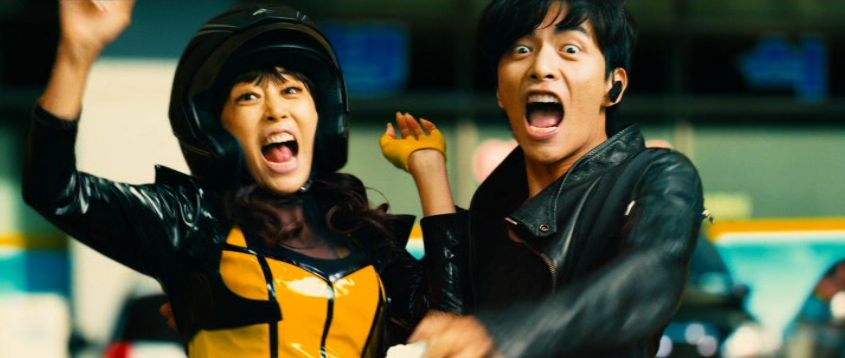
Motorcycle courier Gi-su finds himself trapped into delivering small packages containing extremely potent bombs by an unknown person. The packages must be delivered within a certain time or they will explode, along with Gi-su. Complicating things is that Gi-su, by chance, finds the pick up he as stopped for is actually his ex-girlfriend, Chun-sim, hoping to beat traffic to a scheduled gig. Gi-su's helmet is stuck on Chun-sim, with the threat of explosion if the helmet is removed, or if the two are physically separated by more than ten meters. Pursuing the pair is Meong-sik, a former biking buddy of Gi-su's, desperately trying to overcome his reputation as Seoul's most incompetent cop.
While the emphasis is on the need for speed, my favorite scene is the comic highlight. Not seen for about six year, Gu-si finds out that Chun-sim is now a member of one of South Korea's ubiquitous pop girl groups. While Gu-si fights fans to keep within safe of Chun-sim, the helmeted singer makes a mad dash on stage to maker her performance in time. Trying to avoid explaining that the helmet is not some strange fashion statement, a few moments are given to making fun of the rivalry of the singers within the group.
Quick is the South Korean version of a "popcorn movie", and is enjoyed best with no other expectations. The final scene, with the one last unexploded bomb, is a well realized combination of humor and tension. This is the perfect movie to watch while munching on sweet chili rice snacks.
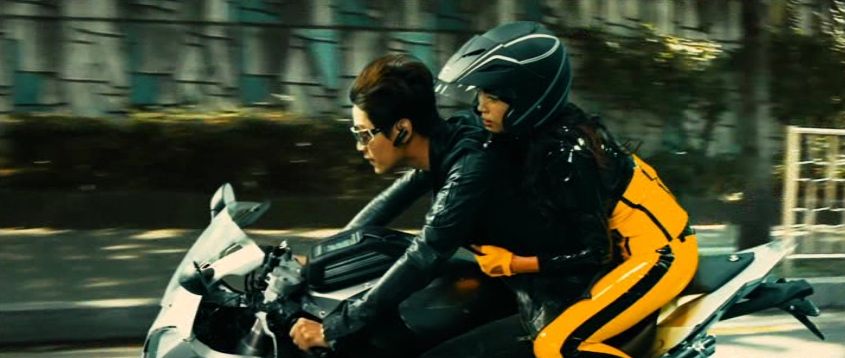
Posted by Peter Nellhaus at 09:44 AM
August 26, 2012
Coffee Break

Vincent Lindon and Audrey Dana in Welcome (Philippe Lioret - 2009)
Posted by Peter Nellhaus at 08:26 AM
August 23, 2012
Cosmopolis
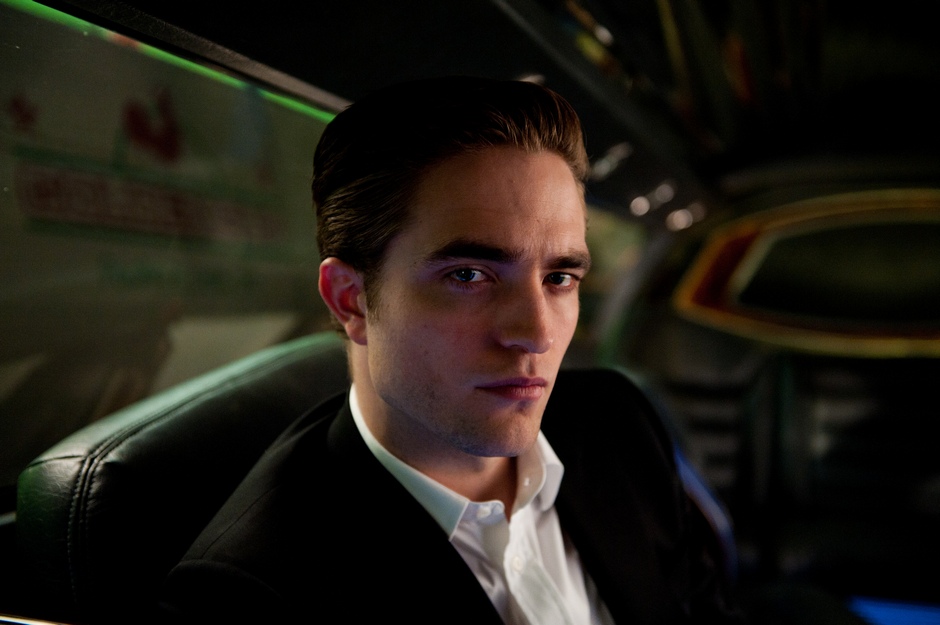
David Cronenberg - 2012
Entertainment One 35mm Film
I don't know if I'm at a disadvantage in understanding what I had seen. I have not read Don DeLillo's 2003 novel. I have seen all of Cronenberg's previous films. As others have written about Cronenberg's Cosmopolis since it premiered at Cannes last May, I feel that recounting most of the narrative is unnecessary.
I feel like what I saw was a science fiction film, sort of like eXistenZ, Cronenberg's 1999 film that took place primarily in virtual reality. To me, Cosmopolis also takes place in a virtual reality or some kind of alternate reality, if not within a dream. Part of what makes me interpret the film that way is because of how the sense of space is disjointed, the way Cronenberg cuts between close-ups of characters, especially in the first scene inside the limo, when your not sure where Eric is sitting in relationship to his employee, Shiner. Characters appear and disappear abruptly as if in a dream. The patterns of speech are also disjointed as if instead of conversations, there are alternating monologues. Listening to people speak to each other often felt like the exchange of words on Facebook rather than actual dialogue. There is also a flatness to Robert Pattinson's speech that made be wonder which made me wonder if I was watching the story of a human being or of someone who only appeared human.

What Cronenberg reminds us is that Eric is not only detached from other people, but also himself. The film can easily be read as a parable of our times. Without naming anyone, one can scan the news about people so wealthy that their main concern is to accumulate more wealth, as well as those whose business dealings enrich themselves at the expense of others. When Eric shoots himself in the hand, it is certainly a crude way to remind himself that he does in fact have real feelings, as well as providing quasi-religious symbolism as a self-inflicted stigmata. While Eric does descend from heights of wealth and insularity, his death would only be for his own sins.
At least for myself, Cosmopolis is not an easy film to write about. This might be due to a sense of emotional and psychological distance while watching the events on screen. Was my own sense of detachment deliberate on the part of Cronenberg? There is something about the characters serving as symbols, and a sense of artificiality in the settings that provide a Brechtian touch here. Even though the story takes place in New York City, a couple of exterior shots were recognizably Toronto, adding to what seems to me deliberate fakery. It may simply be a matter that Cronenberg's version of Cosmopolis is not the kind of film to be written about after a single viewing, but could well benefit from an extended period of time to absorb and understand.
Posted by Peter Nellhaus at 08:23 AM
August 21, 2012
The Viral Factor

Jik zin
Dante Lam - 2012
Well Go USA Entertainment Region 1 DVD
I can't fault Dante Lam for being ambitious. Starting in Jordan, with a brief hop in China, before settling in Kuala Lampur, Malaysia, it seems like Lam was itching to bust out of the confines of Hong Kong. In addition to the chases on foot or by car, there's also a helicopter pursuit through the city. In terms of action set pieces, this is Lam's biggest film, yet it did grab me and leave me breathless like his previous film, The Stool Pigeon.
The story gets a bit complicated, but essentially in begins with Jay Chou as Jon, part of an international paramilitary group attempting to escort a scientist out of Jordan to asylum in Norway. The scientist created a new kind of smallpox virus that can not be treated with current vaccines. One sample of the virus is still in the hands of the scientist as a bargaining chip if there's a problem in getting safe passage. The escort team is ambushed, the scientist is kidnapped, and Jon is left with a bullet in his head and two weeks to live.

A brief reunion with his mother in China ends when Jon is encouraged to seek out the older brother he didn't know he had. The brother, Yeung, is in Malaysia. It also turns out that Yeung is involved with the people who have the virus sample, a criminal gang with plans to profit from biological terrorism.
The Viral Factor is Jay Chou's first film since The Green Hornet, and Lam has made the still boyish looking pop star look a bit more mature, and much grittier than he's appeared previously. The DVD supplemental interview would indicate that Chou is ambivalent at best about doing another demanding action film such as this, but he carries himself well. Nicholas Tse has much been around the block previously with Lam and The Stool Pigeon, and several other action films under his belt. For the most part, The Viral Factor is a two man show with Lam putting his two stars through their paces, matching each other for the most part in stunts and shootouts.
The film gets more emotionally involving near the end with the race against time, with Yeung's kidnapped daughter is infected with the virus and only has a few hours to live. The Chinese title translates as "uphill battle". Both Jon and Yeung are up against obstacles that neither can change, in addition to finding themselves caught between various law enforcement agencies and the criminal gang. Lam revisits themes of people caught in impossible situations that test loyalty or conscious. The action scenes are expertly filmed, if over reliant on lots of editing. Still, I felt The Viral Factor might have been a bit better if Lam had pared down the technical virtuosity in exchange for a little more heart.

Posted by Peter Nellhaus at 08:25 AM | Comments (1)
August 19, 2012
Coffee Break

Juliette Binoche in Certified Copy (Abbas Kiarostami - 2010)
Posted by Peter Nellhaus at 08:28 AM
August 16, 2012
The Sins of Rachel Cade

Gordon Douglas - 1961
Warner Archives DVD
Sometimes you just want to see a movie pretty much for its own sake. And sometimes you discover cinematic art where you weren't seeking it. And over the past few years, I've come to appreciate the craftsmanship of Gordon Douglas, a director I had blithely dismissed back when I was watching films as an academic pursuit. And yes, I am admittedly repeating myself, in using that word, craftsmanship, in discussing Douglas, but the years have revealed that some of his films are smarter, and smarter looking, than some of what currently flits in and out of the multiplexes.
And I wish that Warner Brothers hadn't made it a practice to make their DVDs unplayable on my Macbook. Especially with The Sins of Rachel Cade. People have written about the extreme close ups of Carl Dreyer and Sergio Leone. Gordon Douglas is someone who doesn't get discussed in terms of visual style, so I don't know who gets credit here, but this is a film to be loved and cherished for the close ups of Angie Dickinson. How many are there? I don't know. We're not only talking about full face shots, but several where the bottom of her frame is at her lips, and the top of the frame meets her eye brows. Really, really close. And whether the colors are muted because it was intended that way, or maybe the source print is a bit faded, I don't know, because it works. I've seen Angie Dickinson in several movies over the course of her career, but I've never seen her as lovingly photographed as in this film. If one cut out everything else in The Sins of Rachel Cade, with only the close ups of Angie Dickinson remaining, one is left with a visual poem even more beautiful than what Joseph Cornell did after whittling away all that was extraneous in East of Borneo, leaving the viewer to admire only Rose Hobart.

The close ups aren't reserved exclusively for Angie Dickinson. Other cast members treated well by J. Peverell Marley's camera, his last feature film work, include Peter Finch, Roger Moore and Errol John. But it is the images of Dickinson that are a revelation here, as if I had never really noticed her before.
The premise does seem unpromising, about a missionary nurse from Kansas who shows up in the Belgian Congo right before World War II heats up, bringing western medicine and the word of Jesus to the natives. And some of the film plays by the classic Warner Brothers template, complete with Max Steiner score. And for a film that is in part about faith, it allows for respectful discourse and a generous view of what it might mean to be Christian that could conceivably disturb those with less flexible views. The conclusion might even be thought of as proto-feminist, both for a film that was made in 1961, that takes place twenty years earlier.
The triangle with Dickinson caught between Finch and Moore is the less interesting part of the film. More compelling is seeing several black actors given more opportunity to perform in something other than bit parts - in addition to Errol John, there's also Woody Strode, former Olympian Rafer Johnson, Scatman Crothers, Juano Hernandez and Frederick O'Neal. And sure, it took a film that takes place in deepest, darkest Africa, actually the Warner Brothers back lot, to get this kind of cast together, but there's a sense of respect and dignity afforded to everyone involved.
There is also some unexpected humor. I don't know what Finch and O'Neal were smoking in their pipes, but they let the audience know that it's not tobacco. Also, one of the more convenient plot twists is when Roger Moore literally crashes onto the scene and reveals himself to not only be an unlucky R.A.F. pilot, but also the doctor the village needs.
What may be most amusing is that The Sins of Rachel Cade was often booked in its theatrical run with another Gordon Douglas film, Gold of the Seven Saints, which also had Roger Moore in the cast. The double feature was covered by Eugene Archer for the New York Times, cracking wise about "saints and sinners" and describing the two films as "nostalgic throwbacks" of "old-fashioned movie-making". To all that, I say Amen.

Posted by Peter Nellhaus at 09:00 AM
August 14, 2012
The Life and Death of a Porno Gang

Zivot i smrt porno bande
Mladen Djordjevic - 2009
Synapse Films Region 0 DVD
While the more easily exploitable elements are what is used to sell The Life and Death of a Porno Gang, viewing this film reveals there is much more than what's on the surface. Presented as a video diary of a young Serbian film director, Marko, whose career takes some unexpected twists and turns, the film takes place between 1999 and 2002. There are references to Serbian history that may be lost to the more casual viewer, perhaps the most important being Marko's completely sleeping through October 5, 2000, a significant day for Serbians. It's not the first film to be self-contradictory or self-critical, or to be ultimately nihilistic. What needs to be recognized is that there is some serious intent, and not simply shock for its own sake.
Marko's plan to make a artistic horror or fantasy film is derailed when the only producer who bothers to speak to him deems the project to expensive to be profitable. A career making commercials brings in some money, but little satisfaction. A chance meeting with a porn producer leads Marko to making videos, where he is constantly admonished not to make anything "artsy". The one time Marko makes a film on his own, it's a parody of the kind of films that use to be made in Eastern Europe, of a failed farmer who ends up, as the Bible would put it, spilling his seed on the arid farmland. Between the film the producer can't sell, and the money lost for another production, Marko decides to change his career.

Creating a group that performs on stage, combining sex with political and social commentary, Marko soon hits the road with his group where they perform in various rural villages. An older man, a German journalist with international connections, offers Marko and the gang a substantial sum if they make the occasional "snuff" film with volunteer victims. The acceptance of the offer brings about inevitable consequences.
One can describe both the publicly staged performances of the porno gang and the film itself as having antecedents with Grand Guignol, and to some extent the concept of the Theater of Cruelty, or even The Living Theater's production of "Paradise Now". And it could well be that I am reading more into this film than may have been intended by Mladen Djordjevic, but then the history of film, in part is the discovery of connections and meanings that may have not been consciously included by filmmakers. An interview with Djordjevic indicates interest only in the more superficial aspects of this film.
Am I reading too much into what I've seen? Perhaps. And I think that by centering a story on a group of people who are self-described failures, trying to give their lives their lives meaning, Djordjevic is attempting to be confrontational about life in Serbia. Capitalism as it exists is at its most raw. The impulses that led to ethnic cleansing in the former Yugoslavia are not far from the surface. I can't really say whether The Life and Death of a Porno Gang is a "great" film or even a "good" film. For myself, what Djordjevic is describing about the human condition, marginalized people, and the commodification and spectacle of sex and violence, makes aesthetic judgments besides the point.

Posted by Peter Nellhaus at 08:01 AM | Comments (1)
August 12, 2012
Coffee Break

Maria Bello and Robin Wright in The Private Lives of Pippa Lee (Rebecca Miller - 2009)
Posted by Peter Nellhaus at 08:28 AM | Comments (1)
August 10, 2012
The Raid: Redemption

Serbuan maut
Gareth Evans - 2011
Sony Classics Region 1 DVD
What will probably be the most memorable quote in this film comes from a short, wiry guy with the nickname of Mad Dog, "Pulling a trigger is like ordering a takeout." Not that there isn't a lot of shooting in The Raid: Redemption, in fact there is a lot. And some of it is point blank, gun barrel against a guy's head. The above quote precedes Mad Dog taking on a cop in a hand to hand martial arts duel.
The story itself is relatively simple. A Jakarta based SWAT team goes to a crumbling high rise that's the base for a local crime boss. Part of their justification is that it is known that a drug lab is in the building. What makes this task more of a challenge is that many of the high rise residents are also gang members. It's also explained later why the members of the SWAT team are for the most part an untested bunch. The crime boss, Tama, is vicious enough to have no problem personally executing his enemies. His trusted lieutenants are the previously mentioned Mad Dog, and the more organizationally inclined Andi. Even though the SWAT team works its way up through the high rise, each floor might be said to correspond with a deeper level of Hell.

What is to be admired about The Raid: Redemption is the complexity of fight scenes. These scenes use a variety of different martial arts styles. In addition to guns, the weaponry gets more personal with machetes and knives. Evans did some of the action choreography, as well as edited the film. To describe what happens on screen as fast and furious is probably a cliche but anyone with a modicum of knowledge on how movies are actually made should be impressed by how the very fast shots have been assembled to create, for the most part, seamless action sequences with very convincing looking stunts and body movement.
This is a man's man's man's world, and the three women who briefly appear are wives left in bed, one sick, one pregnant. There are a few brief shots of the streets of Jakarta, but most of the film takes place in this one building. There's already an English language remake in the writing stage which will probably tone down much of the violence, but hopefully encourage subtitle adverse viewers to watch Evan's original film.
That The Raid: Redemption is the first Indonesian film to get picked up by a major U.S. distributor is a worthy breakthrough. There is some irony that it's also the work of a Welshman. Not to take anything away from Gareth Evans, who has made a small scale international hit with his second dramatic feature, but ideally his film would inspire further interest in Indonesian cinema. Considering the state of seeing Asian cinema in the U.S., I have no reason to be optimistic, but then again, a couple of action movies from Vietnam have made their way stateside. In the meantime, Evans has left his movie with enough of an open ending to look forward to his sequel. Considering what was accomplished with the limited resources he had available, Evans has set the bar quite high for a rematch.

Posted by Peter Nellhaus at 08:23 AM
August 08, 2012
Laddaland
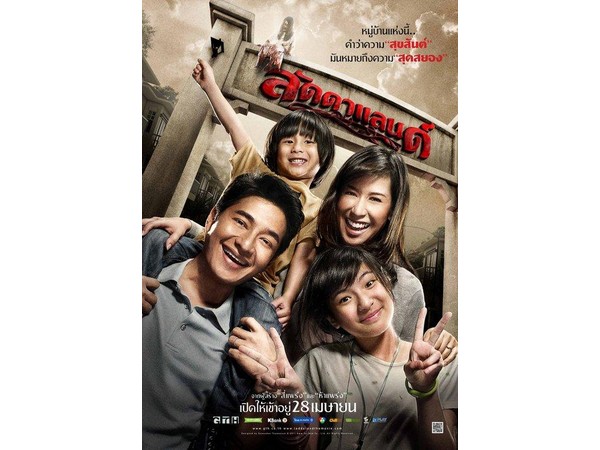
Sopon Sukdapisit - 2011
Vicol Entertainment Region 3 DVD
Part of my interest in seeing Laddaland was simply because it takes placed in Chiang Mai, the Thai city I lived in for several months back between the November of 2006 through March of 2007. Between simply living in Thailand, and watching a fair number of Thai movies, what I've learned about ghosts is that if you don't bother them, they won't bother you. A more arrogant westerner might walk by a little ghost house and think that what they see is an expression of outdated superstition. I prefer to think that maybe someone knows something that I don't. In any event, I lived fairly close to the city center, so I have to assume that the ghosts there have been pretty well settled.
Laddaland takes place in an upscale suburb, with good size western style houses with Thai influence, in a gated community called Laddaland. Thee is preparing his house for his wife and family. Wife Parn, and young son, Nat, are excited by their new home. Teen daughter, Nan, is more cynical, stating that she'll stand for a family portrait in front of the new house when the mortgage is paid off. Things look rosy until that first night when a candle is accidentally knocked over, starting a fire in the couple's bedroom, followed by the unwanted visits by the black cat owned by the family next door. More ominously, a woman has been found murdered and mutilated, stuffed in the refrigerator in a house down the street.
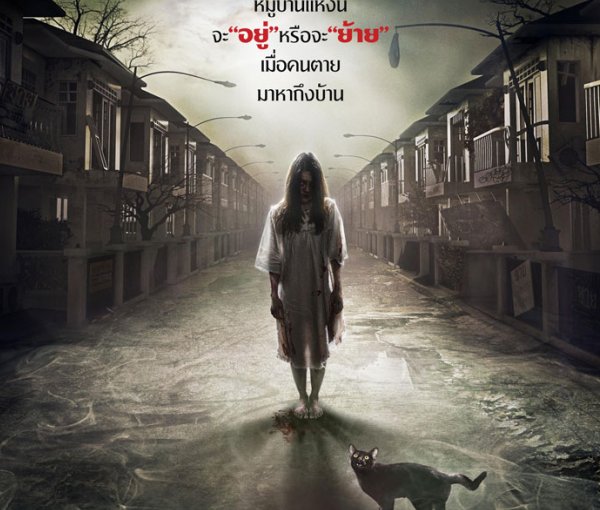
Laddaland is closer to more western horror films, than most Thai films. Their is no explanation as such tying the presence of ghosts to anyone wrongdoing, or unfinished business, nor does anyone seek assistance from any Buddhist priests. The ghosts, when visible, are seen very fleetingly. To give a somewhat better idea, as a genre piece I would place it closer to The Sixth Sense in its depiction of the supernatural. As can be expected, it is the children who see the ghosts first, only to be challenged by disbelieving parents.
Simultaneous to this is the disintegration of Thee's life and family. Thee leverages himself not only with the purchase of the house, but other goods that he thinks he can afford. Thee's only had his good paying job for three months before committing himself to move to Chiang Mai from Bangkok. If the next door neighbors are an indication, Laddaland seems to be a magnet for people whose fortune, literally and spiritually, as run out. For Sopon Sukdapisit, the greater horror might not be the ghosts next door, but finding oneself without money and nowhere to go.
Laddaland is Sopon's second film as director. His previous film, Coming Soon was a more explicit horror film taking place mostly in a haunted movie theater. It should be noted that Sopon had a hand in the screenplays for Shutter and Alone, two of the most notable Thai horror films, Alone sadly not getting even a stateside DVD release as interest in so-called Asian Extreme movies fell out of favor with the sub-par Hollywood remakes. Also, Sopon's film garnered eight nominations from the Thailand National Film Awards, with six wins including Best Picture, and Best Screenplay for Sopon and Sopana Chaowwiwatkul.
Posted by Peter Nellhaus at 07:49 AM
August 06, 2012
Warriors of the Rainbow: Seediq Bale

Wei Te-Sheng - 2011
Well Go USA Entertainment Region 1 DVD
First, let me advise readers that the version I saw is the shorter release with a running time of about two and a half hours. Ideally, I would have seen the original version five hour version. I don't know what I've missed, but this shorter version worked well enough for me to overcome most of my concerns.
This is a Taiwanese national epic about Japanese occupation prior to World War II, and the guerilla warfare of several aboriginal tribes in what has been referred to as the Wushe Incident of 1930. And while some aspects might be culturally specific to the place and time, there is enough for those aware of other histories to see parallels with, for example, native Americans, or Vietnam. On a more visceral level, there is simply the excitement and fascination of seeing a smaller band of people at war against a larger, better equipped enemy.

The film mostly centers on Mouna Rudao, introducing him first as a young man, earning his warrior tattoos on a hunt. The film jumps ahead to an older Rudao, seemingly at peace with the Japanese occupation that has transformed the region where he and his tribe live. As was customary in other countries of Japanese occupation, some would take take on Japanese identities and work with the Japanese authorities, even though they would still be considered as second class citizens. In this film, two members of Rudao's tribe are members of the local police force, wearing the same uniform, although paid less. The tribesmen are consigned to cutting down the forests, part of the exploitation of Taiwan's natural resources, but additionally destroying the Seediq peoples traditional way of life. Continual mistreatment by the Japanese authorities causes Rudao to plan war against the people he considers intruders, although this is tempered by the animosity that continues with rival Seediq tribes.
What I have been able to glean from other sources is that Wei was able to cast the primary roles as authentically as possible, so that the Seediq people are portrayed by actors of aboriginal descent. Lin Ching-Tai, is not a professional actor, yet he is able to carry most of the work as Mouna Rudao. Possibly the best known actor in the pan-Asian cast would be Masanobu Ando who plays a Japanese policeman who has a more respectful attitude towards the Seediq, at least in the beginning of the film. Also, Seediq is the spoken language in the film, as well as Japanese, and some Chinese, making the film linguistically authentic.
One part of the film that would benefit from explanation are songs performed by the characters. I assume these are traditional Seediq folk songs. In any event, one of the songs provides a particularly interesting counterpoint to the action, a melancholy song about the implications of going to war, where a lesser filmmaker would more likely use some kind of rousing music to signify victory.
Normally, "Making of" DVD supplements are not always of interest. Here though, it is worth having Wei discuss the origin of making the film, the various obstacles in getting financing, and the logistical problems with a large cast and crew in a somewhat remote location. One of the people who appears frequently and is seen dealing with various logistical problems, is Wei's assistant director, Anne Wu. Don't be surprised if Miss Wu moves into the director's chair sometime soon.

Posted by Peter Nellhaus at 07:13 AM
August 05, 2012
Coffee Break
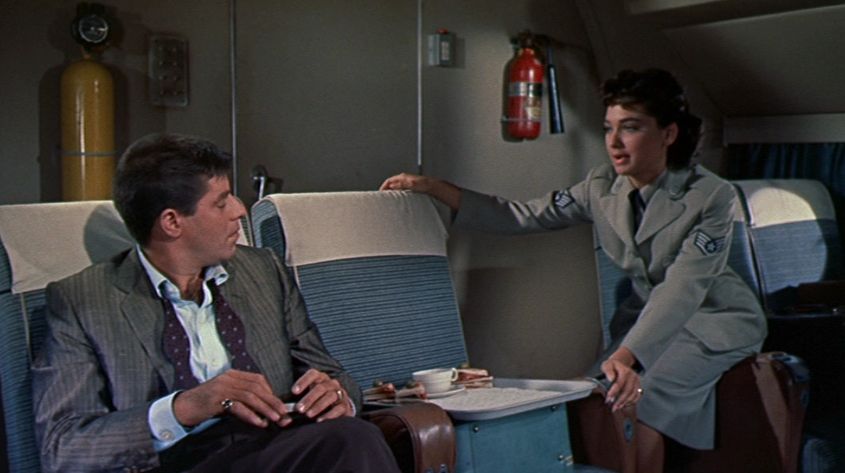
Jerry Lewis and Suzanne Pleshette in The Geisha Boy (Frank Tashlin - 1958)
Posted by Peter Nellhaus at 09:50 AM
August 03, 2012
Oslo, August 31st
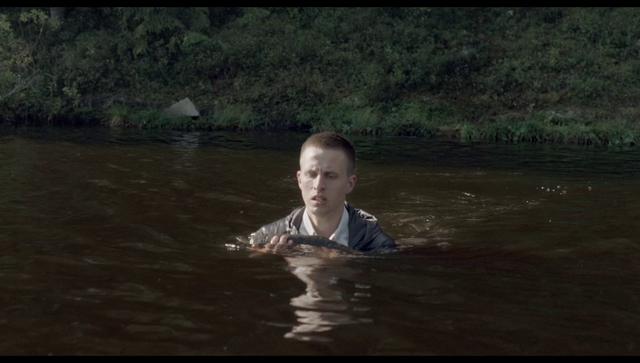
Oslo, 31. august
Joachim Trier - 2011
Strand Releasing
Even though it was written in 1931, Pierre Drieu La Rochelle's story, Le Feu Follet, a story of an addict's final day, has proven to have be easily retold on film for at least two generations. The previous version, Louis Malle's, with the English title of The Fire Within, was made almost fifty years ago, in 1963. Joachim Trier has transposed the basic narrative to contemporary Oslo, Norway.
The importance of the city is established by the opening of the film. A montage of shots of Oslo past and present are accompanied by voices of people stating their first impressions of Oslo, or how living in Oslo changed their lives. For Anders, released for the day from the rehab clinic to go to a job interview, Oslo is meant to be a place for him to restart his life as a recovering drug addict. Instead, all of the past connections represented by the city pull Anders into a downward spiral that ends in a complete surrender.
In an interview, Trier explains, " I think it was an honest portrayal of a person who is underneath and above at the same time. Nothing is good enough for him, so therefore he'd rather die than to be like the others. He's saying 'What's the way forward? What constitutes value in our life as creative people or as middle class people with choices?' The character in the book is also quite resourceful, like Anders is. They're different - different culture, different time - but they still share that they have choices and yet they don't know where to go."
I might be wrong, but I suspect that had someone made a film of La Rochelle's story, taking place at the time it was written, the still contemporary aspects to the story would not be as easily recognized or acknowledged. And in a way one might consider Trier's film radical in that not many, if any filmmakers nowadays make movies about alienation. The only others I can think of would be Gus Van Sant with Last Days and Lynne Ramsey's We Need to Talk about Kevin. Even if Anders did not do some of the various acts that undermine his recovery and reentry to society, it would be naive to assume that there would be any meaningful difference in his life.
The film end with a montage, yeah, I'm using that Cinema Studies 101 term again, of shots of Oslo again. No dialogue, only images of empty streets, of a city shut down for the night. I don't know whether this was deliberate or not, but it reminds me of the ending of another film that was made about the same time as Malle's. Michelangelo Antonioni's L'Eclisse, another classic film about urban alienation that ends with a series of shots of a deserted Rome.
There may be arguments regarding the influence of a city on a person's life. This has been explored with cities in general, specific cities, and even very specific neighborhoods. The return to Oslo causes Anders to seek out people and revisit events from the past that are connected to that city. In one scene, Anders overhears conversations in a restaurant populated by other people in their twenties and thirties, discussing their possibilities and choices and dreams for life. In another scene, Anders provides a voiceover about his parents and how they influenced him, or did not, with their own lives and opinions. What Anders cannot do is change, or in any way repair past events. Nor does he see any validity in some of the options made available to him. Sadly, Anders chooses the path of least resistance to the indifference of life.
Posted by Peter Nellhaus at 08:27 AM
August 01, 2012
A Tale of Archers at Sanjusangen-do

Sanjusangen-do, Toshiya Monogatari
Mikio Naruse - 1945
A story about a samurai era archery competition is not something to be expected from Mikio Naruse. Even if the subject matter seems out of place for a filmmaker better known for his domestic dramas, Naruse's hand is definitely there visually.
The traveling shot of the main characters walking, with the camera framed just ahead, with a wall in the background, filmed at a mildly diagonal angle is used again here. I think of this type of shot as one of Naruse's visual signatures. In this film, we see Kazuo Hasegawa and Sensho Ichikawa walking down the road, having a friendly chat. Another brief shot that Naruse includes in other films is that of a reflection in a mirror. Here we briefly see Kinuyo Tanaka checking her hair. The shot is something of a visual joke, cut directly after a shot of Ichikawa shooting an arrow.
The story, as such, is about Ichikawa as the son of a famous archer, preparing to compete to redeem the family name, as his father, the region's previous champion, committed suicide under questionable circumstances. Tanaka is the woman who raised Ichikawa, currently running a hotel. Hasegawa is the stranger in town, who comes to mentor Ichikawa in the art of archery.
Filmed in Kyoto during the last months of World War II, the film might be interpreted as apolitical. Rather than being a call for nationalism, or extolling the virtues of loyalty to the emperor, the film might well be seen as gentle encouragement to overcome feelings of defeat. Much of the time, until Hasegawa comes on the scene, Ichikawa complains that he is unable to even come close to the record of 8000 target hits. Hasegawa's cover is dropped when he finds out that his mother is in town. Whatever A Tale of Archers is, or isn't about, filial loyalty trumps everything else.
There is a brief scene of action, with the baby faced Hasegawa taking on a small gang of ruffians. And who doesn't love watching the lone samurai whipping out his sword to take several challengers at once? Naruse strong suit would still be the battle of wills between his characters, but it's still a pleasure to watch the kind of scene normally not associated with his better known work.
Kazuo Hasegawa and Kinuyo Tanaka have had long, well documented careers, working with several of the top Japanese directors over several decades. Sensho Ichikawa is the question mark here. What little I could find indicates a brief career with hardly a handful of credits. Based on several online searches, it would appear that A Tale of Archers was Ichikawa's final film following three other films made in the late Thirties. Hideo Oguni, the screen writer, is better known for his collaborations with Akira Kurosawa. As such, the scene of Hasegawa's sword fight in the streets appears in retrospective to have been a rough sketch for the kind of scenes Oguni would write for Toshiro Mifune.
Posted by Peter Nellhaus at 07:48 AM
